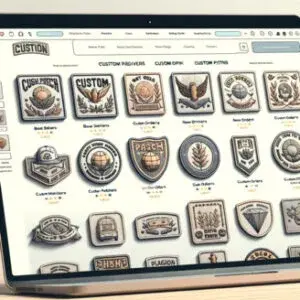A Guide to Starting a Pin Business
Pins have made a stylish comeback, especially with Gen Z embracing nostalgic and alternative fashion trends. These small yet impactful accessories blend art and wearability, making them a popular choice for collectors and fashion enthusiasts alike. If you’re a creative entrepreneur looking to dive into the pin business, you're in luck! Starting a pin business can be a fun and profitable venture. Follow our easy-to-follow guide to launching your own successful pin business and turning your passion into profit.
Why Start a Pin Business?
If you browse through marketplaces like Etsy, you’ll quickly see a wide range of custom-designed products—t-shirts, tote bags, and more. While there are many ways to make money selling custom items online, why should you choose custom pins? Here are some compelling reasons why starting a pin business is a smart move:
- Compact and Lightweight: Pins are small and lightweight, making them cost-effective to ship and easy to store. This leads to reduced overhead costs and higher profit margins for your business.
- Low-Risk Investment: Unlike other custom products like clothing, creating custom pins requires a relatively low upfront investment. This makes it an ideal business for entrepreneurs on a budget.
- Growing Market: The custom pin market continues to expand. People are increasingly drawn to the charm of unique pins, and their popularity shows no sign of slowing down. It’s a thriving niche with plenty of room for growth.
- Broad Appeal: While pins are especially popular among younger generations, they also attract collectors and fans from various subcultures and age groups. Whether it’s pop culture, art, or niche fandoms, pins have a diverse customer base.
In conclusion, custom pins are an excellent product to launch your online business. They’re affordable, in high demand, and easy to manage. Plus, their low production costs allow you to offer them at accessible price points, appealing to a wide audience and maximizing your potential customer base.

How to Start a Pin Business: A Step-by-Step Guide
Are you ready to start selling custom pins? Whether you're interested in creating enamel pins or another type of pin, launching your own pin business is easier than you might think. Follow these simple steps to get your pin business up and running:
Step 1: Identify Your Target Audience
Before diving into designing your pins, it’s crucial to define who you’re designing for. Are you targeting fans of a specific TV show, gamers, comic book enthusiasts, or maybe a different niche?
Understanding your audience will shape everything—from the types of designs you create to how you market and sell your pins. A clear grasp of your target market will help you create custom pins that resonate with potential customers.
It’s often best to start with a specific niche and expand to a broader audience over time. Why? Because focusing on a smaller, more targeted market makes it easier to stand out, build a loyal customer base, and gain traction before competing with larger, more established brands.
Step 2: Create Your Designs
Now comes one of the most exciting—and crucial—steps: designing your pins. If you're a creative person, you might be eager to start sketching your ideas. To help you create the best possible custom lapel pins, here are a few tips to keep in mind:
- Know Your Audience: Think about what will resonate with your target market. While it’s helpful to check out what other pin businesses are doing for inspiration, don’t forget to add your unique twist to stand out.
- Keep It Simple: Since pins are small, intricate designs may not translate well. Bold, clear, and easily recognizable designs tend to perform the best in the world of lapel pins.
- Avoid Copyright Issues: Make sure your designs are original and do not infringe on existing intellectual property. Protecting your creative work is key to building a trustworthy brand.
Need Help? If you're not a designer, no problem! You can collaborate with a professional artist or designer to bring your vision to life. Once you have your design (whether hand-drawn or digital), seek feedback from friends, family, or even members of your target audience to refine it further.
Step 3: Choose Your Production Method
With your designs ready to go, the next step is to decide how to produce your pins. The most common production methods include:Soft enamel pins: These are the most popular type of enamel pins. The design is created by filling recessed metal areas with colored enamel and then baking it to achieve a textured, shiny finish. Soft enamel pins are affordable and widely loved for their vibrant look.
Hard enamel pins: Similar to soft enamel pins, hard enamel pins use individually created colored enamel that is baked together, resulting in a smoother, more durable finish. These pins are slightly more expensive but are perfect for designs that require a bold, polished appearance.
Die struck pins: Made by stamping a design into the metal surface, die struck pins are then polished and plated. These pins don’t feature colored enamel but have a clean, elegant look similar to a coin. They’re great for a minimalist, classic aesthetic.
Printed Pins: Printed pins are made by directly printing a design onto the metal surface of the pin. This method allows for intricate, detailed designs and can be finished with an epoxy coating for a glossy or dome-like effect.
Depending on your design preferences, the overall look you're aiming for, and your budget, you can select the production method that best aligns with your vision and needs.

Step 4: Find a Manufacturer
Unless you have an advanced home production setup—complete with a metal press and enamel oven—you’ll need to partner with an external manufacturer to produce your lapel pins. Here are a few options to consider:
- Dropshipping: With dropshipping, you find a company that will create and ship your pins directly to customers. This option is ideal if you want to avoid holding inventory. However, you'll have limited control over the design process, as the company typically offers pre-made designs, and they take a portion of the profits.
- Print on Demand (POD): Print on demand is a popular model for products like T-shirts and tote bags, but it’s not typically an option for custom pins. The production process for pins is more complex, and most POD companies only support simple button pins rather than custom enamel designs.
- Custom Manufacturers: If you want full control over your design and production, working with a custom manufacturer is your best bet. This option lets you collaborate directly with a manufacturer to bring your pin designs to life. While the upfront investment is usually higher compared to dropshipping, it’s the only viable option if you want to create truly unique, high-quality custom pins.
At THE/STUDIO, we offer fully customizable pins to suit your unique vision. You can choose your production method, design, size, shape, finish, color, and even select upgrades like glitter enamel or different backing attachments. We work closely with you to bring your ideas to life!

Step 5: Create a Strong Brand Identity
As you launch your lapel pin business, establishing a distinct brand identity is key. A strong brand helps your pins stand out in a competitive market and makes your business more memorable. You want your customers to think of your brand whenever they think of custom pins. Here’s how you can build a powerful brand identity:
- Choose a Brand Name: Select a unique and memorable name that reflects your brand’s personality. Avoid generic names and aim for something creative and catchy that resonates with your target audience.
- Design a Logo: Your logo is the face of your brand. Make sure it’s simple, versatile, and aligns with your brand’s style and values. A strong logo will help customers instantly recognize your brand.
- Establish a Color Scheme: Choose a set of colors that reflect your brand and use them consistently across all your branding materials. Consistent use of color creates a cohesive and recognizable brand image.
- Tell Your Brand Story: People love stories, so if there’s an interesting or fun story behind your brand, share it! A compelling brand story helps customers connect emotionally with your business.
- Create a Brand Voice: Your brand’s voice is how you communicate with your customers. Will you be friendly and quirky, or sleek and professional? Defining your communication style helps establish a deeper connection with your audience.
- Focus on Packaging and Presentation: Don’t underestimate the power of packaging. The way you present your pins is an extension of your brand identity. Thoughtful packaging not only enhances the customer experience but also reinforces your brand’s image.
Step 6: Set Up Your Online Store
Your online store is the key to connecting with your customers and growing your pin business. Even if you don’t have the budget or technical expertise to create a fully custom website, there are plenty of options available that don’t require massive upfront investment.
Here are some popular ways to sell custom pins online:
- Online Marketplace Platforms: Selling on established marketplaces like Etsy or eBay allows you to tap into their large audiences and established customer bases. This is a great option if you don’t want to build a website from scratch but still want to reach a broad audience.
- E-Commerce Website Builders: Platforms like Shopify, Wix, and Squarespace offer easy-to-use templates that allow you to create a professional-looking online store without any coding experience. While there is usually a cost involved, it’s much more affordable than hiring a web developer and gives you complete control over your store.
- Social Media Selling: Social media platforms like Instagram and Facebook are powerful tools for selling custom pins directly to your audience. Many small businesses start by leveraging their social media pages to sell before expanding to a dedicated e-commerce website. These platforms make it easy to showcase your pins and engage with potential customers.
Step 7: Decide How You’ll Fulfill Orders
Efficient order fulfillment is crucial to the success of your pin business. Without a solid plan in place, it can quickly become a logistical headache. Here are the key areas to consider when planning how to fulfill orders:
- Inventory Management: How will you track your stock levels and ensure you have enough pins to meet customer demand? Using basic inventory management software or even spreadsheets can help you stay organized and avoid stockouts.
- Shipping Options: Will you offer free shipping, flat-rate shipping, or real-time carrier rates? Research different shipping carriers and their costs to determine the best option for your business and customers. Offering multiple shipping choices can enhance the customer experience and boost sales.
- Fulfillment Methods: Will you fulfill orders yourself or partner with a third-party fulfillment service? Fulfilling orders in-house is a cost-effective option, especially for smaller businesses. However, as your business grows, outsourcing fulfillment to a third-party service can help you save time and focus on other important aspects of your custom pin business.
Step 8: Start Marketing Your Pins
Marketing is a key driver for sales and business growth. The “If you build it, they will come” mentality doesn’t apply when selling custom pins (or any product, for that matter). To succeed, you need to actively promote your brand and target the right audience who will be interested in your pins.
While advertising can get expensive, there are many affordable marketing strategies to get started:
- Organic Social Media Marketing: Social media platforms offer a cost-effective way to market your pins. While paid ads are an option, creating fun, attention-grabbing content can generate organic interest. With creativity and effort, you can build a loyal following without spending a lot of money.
- Collaborations: Partnering with other small businesses or influencers in your niche is a great way to reach new audiences. Whether through co-branded lapel pin designs or cross-promoting each other's products, collaborations can expose your brand to a broader community without being overly promotional.
- In-Person Markets and Events: Look for local maker markets, craft fairs, or events where you can showcase your pins. Renting a booth allows you to interact directly with customers, get feedback, and make sales. Be sure to promote your online store and social media channels at these events to continue building your online presence.
- SEO Strategies: If you have a website, SEO (Search Engine Optimization) is essential for improving your site’s visibility on search engines. Research relevant keywords and incorporate them into your content to boost rankings. Additionally, online marketplaces like Etsy and eBay have their own search algorithms that you can optimize for better discoverability.
- Paid Advertising: If your budget allows, paid ads can help expand your reach. Platforms like Google, Facebook, and Instagram offer targeted ad options to connect with potential customers who are already interested in pins or related products.

Step 9: Start Selling Your Pins!
Now that you’ve followed the previous steps, it’s time to start selling your pins! With your custom pins ready and your marketing strategies in place, you’re set to launch your business. As your lapel pin business grows, you'll have opportunities to refine your approach, test new strategies, and expand your offerings.
To continue building momentum, consider reinvesting some of your profits into the business. Use this income for advertising, creating new designs, upgrading packaging, or any other areas that can help elevate your brand and attract more customers.
With hard work, creativity, and dedication, your passion for pins can transform into a thriving business. Keep refining your approach, and remember that the key to success is offering unique, high-quality pins that resonate with your audience.
Partner with THE/STUDIO for High-Quality Pins
At THE/STUDIO, we make it easy to turn your custom pin designs into high-quality, tangible products. With low minimum order quantities and fast turnaround times, we help you create personalized lapel pins that are ready to sell in no time.
Our ordering process is simple and straightforward. Just create an account, upload your design, choose your customization options, and place your order. Once your order is placed, we’ll send you a sample to ensure everything meets your expectations before proceeding with full production.
Need assistance? Our pin experts are always available to guide you through the process and answer any questions you may have. Start creating and selling your unique pins today with THE/STUDIO.
Kickstart your designs with AI
Leverage the power of AI to streamline your design process,
turning your ideas into polished, production-ready products with ease.
FAQs
How do I set up a pin business?
1. Identify your target audience and select a niche within the pin market.
2. Create a strong brand identity and design unique pins that appeal to your audience.
3. Partner with a reliable custom manufacturer, like THE/STUDIO, to produce your pins.
4. Set up an online platform to sell your pins, whether through your own website or social media pages.
5. Implement marketing and advertising strategies to attract potential customers.
6. Continuously refine and expand your business to grow your brand and reach new customers.
How do you make money selling pins?
You make money by selling pins at a markup price. The price you charge for each pin should be higher than the production cost, allowing you to earn a profit. The markup can depend on factors like the complexity of the design, popularity, and demand.
How much does it cost to create a pin?
The cost of creating a pin varies based on factors such as the type of pin, any customization options or upgrades you choose, and the order quantity. Use THE/STUDIO’s easy ordering process to get an instant quote for your custom pin design and quantity.
Do enamel pins sell well on Etsy?
Yes, enamel pins are very popular on Etsy. Thousands of sellers make successful sales with enamel pins, often fulfilling hundreds or even thousands of orders for each design. Etsy is a thriving marketplace for pin entrepreneurs, making it a great platform for selling your creations.




